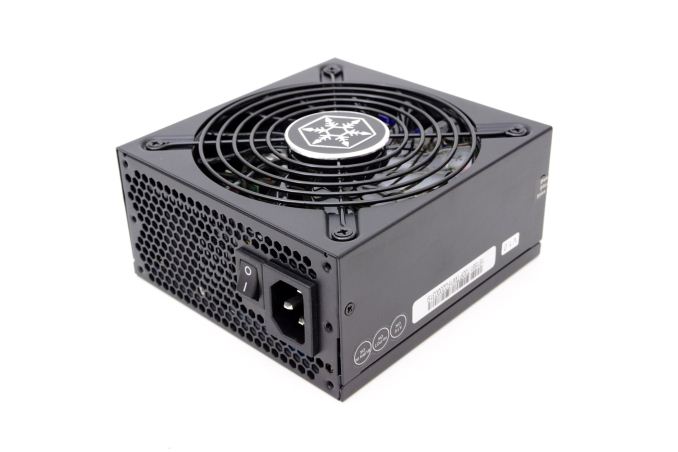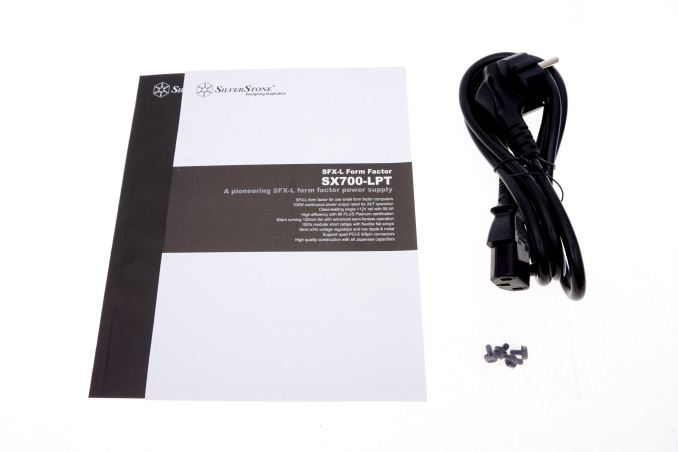The SilverStone SX700-LPT SFX 700W PSU Review
by E. Fylladitakis on September 30, 2016 9:00 AM EST- Posted in
- Cases/Cooling/PSUs
- PSUs
- SilverStone
- SFX

As PC gaming continues to grow, more and more PCs are finding their way into the living room. As such, the demand for small, elegant computers that are powerful enough to be used as gaming machines is constantly on the rise. Several reputable manufacturers have presented products specifically designed for living room PC gaming, from subtle gaming cases to specialized keyboards/mice.
One major challenge with developing these small form factor (SFF) gaming systems is power. A gaming PC can require a lot of power, which can be an issue with cases that only support SFX PSUs. As the market for SFX units is very low and such systems were not expected to have high power requirements to begin with, there are very few designs available with a power output higher than 500 Watts.
SilverStone is a company that is strongly focused on the design and development of SFF cases, with several of their recent products designed to be used primarily as gaming machines. They are one of the very few companies that offer advanced, high performance SFX PSUs. In this review we are having a look at the SX700-LPT, their latest and greatest SFX PSU design. The SX700-LPT is 80Plus Platinum certified and has a maximum power output of 700 Watts, theoretically making it the most advanced consumer SFX PSU available today.
| Power specifications ( Rated @ 40 °C ) | |||||
| AC INPUT | 100 - 240 VAC, 50 - 60 Hz | ||||
| RAIL | +3.3V | +5V | +12V | +5Vsb | -12V |
| MAX OUTPUT | 22A | 22A | 58.4A | 3A | 0.3A |
| 120W | 700W | 15W | 3.6W | ||
| TOTAL | 700W | ||||
Packaging and Bundle
SilverStone supplies the SX700-LPT SFX PSU into a relatively large cardboard box for an SFX PSU. The box is very sturdy and the PSU is sandwiched between thick polystyrene foam pieces, providing ample shipping protection. The most basic features of the PSU can be read at the front side of the box and more details are printed on the back.
The bundle of the SX700-LPT is spartan, with the company supplying only a manual, an AC power cable and four black mounting screws. The manual is extensive and detailed. SilverStone does not provide a SFX to ATX adapter with the SX700-LPT, which is peculiar considering that they do with less powerful units.
This is a fully modular design so every cable can be detached, including the 24-pin ATX cable. All of the cables are "flat", ribbon-like, including the thick 24-pin ATX cable. Apparently, SilverStone is trying to save as much space as possible. Be warned that these cables are much shorter than those of a regular ATX unit, with the ATX power cable being just 30 cm (11.8") long. Every cable is made by using black wires and black connectors, with the sole exception of the PSU-side connectors of the PCI Express power cables, which are blue.
| SilverStone SX700-LPT SFX 700W | ||
| Connector type | Hardwired | Modular |
| ATX 24 Pin | - | 1 |
| EPS 4+4 Pin | - | 1 |
| EPS 8 Pin | - | - |
| PCI-E 6+2 Pin | - | 4 |
| PCI-E 8 Pin | - | - |
| SATA | - | 9 |
| Molex | - | 3 |
| Floppy | - | 1 |













48 Comments
View All Comments
Valantar - Sunday, October 2, 2016 - link
Lian Li recently launched some very interesting mATX/ATX cases limited to SFX-L PSUs. The point of this is that ATX PSUs - most of which exceed the ATX length spec, even, are a massive waste of space in most PCs. Just look how small the Cerberus is thanks to using a small PSU - and that's mATX with SFX-L. Having more choice is never a bad thing, and a wider selection of SFX/SFX-L PSUs will only add to the amount of cases supporting them. The current lack of cases, even for ITX, is simply due to there until recently being NO decent SFX PSUs for those of us wanting to use a GPU. SilverStone started this with their 500W SFX-L and 650W SFX, and others are jumping in. More cases = more PSUs again = more choice for users. This is good. We're growing past the need for huge towers being the norm for any and all PCs. With modern technology, a small, high-performance PC is more than feasible.tb752 - Tuesday, January 19, 2021 - link
Good day sir, it's 5 years on and I have an overclocked Strix 6800xt I'd like to put in an SFF case, so I'm glad this PSU exists!xenol - Friday, September 30, 2016 - link
I have no idea why this would need to exist other than being a dancing bear. I have a i7-6700 and a GTX 1080 in a mini ITX build and it pulls about 250W off the wall under loadDanNeely - Friday, September 30, 2016 - link
Unless you've unclocked/volted your parts somewhat you're not at full load. Combined TDP for the two parts is 245W, which means that (ignoring your ram, chipset, ssd, fans, etc) you'd need a 98% efficient PSU to only hit 250W; and as edziebra noted above higher end parts can put an mITX build well past the sweet spot on a 500W unit. In particular while a Titan is an exceptionally exotic beast; assuming that a future generation of AMD and NVidia GPUs ends up much more competitive in performance/watt, we'll probably see 250-300W mainstream cards again.BrokenCrayons - Friday, September 30, 2016 - link
I doubt xenol's system, when loaded pulling 250W will require over 250W more if its asked to do as much as absolutely possible. A 500W PSU is _very_ reasonable for a single GPU & single CPU system. Since power supply manufacturers have begun to compete more aggressively with one another, the idea of what people think they need to feed their PCs has climbed too. Often the rated output of a PSU an end user thinks is necessary is far in excess of what's actually needed for a given scenario. It seems the most oft cited reason for the unused headroom is "future upgrades" which I don't think is reasonable in a world where most consumer computer parts are designed first with mobility in mind where power and heat constraints are significant rather than the less limited desktop environment that's now playing second (well maybe 3rd or 4th behind phones, tablets, and laptops) chair.Samus - Saturday, October 1, 2016 - link
380-530 watts is the perfect window for a single CPU/GPU system, depending on the CPU/GPU. You don't want to ever run your PSU over 80% load, but you don't really want to run it under 10% load, either.I typically build my PC's to use 60-70% of the PSU capacity at maximum load to leave room for overclocking, adding another drive/memory, etc. I just assume if I'm going to upgrade the video card it'll be the same tier generational bump which is typically around the same TDP (770 to 970 to 1070 have all been within 30 watts of each other.)
Basically, you don't want to put a 800 watt PSU in a single GPU system and you don't want a 500 watt PSU in a dual GPU system. It's safe to assume 100 watts for each Intel CPU+chipset (150 watts for each AMD CPU+chipset) and 200 watts for each video card. RAM 3 watts/DIMM, SSD/HDD 5 watts each, fans 2 watts, liquid cooling 5 watts, DVD 5 watts, PCIe cards are a variable 10-70 watts depending on the card, with most 1x being 10-25 watts.
TheinsanegamerN - Monday, October 3, 2016 - link
Or go by actual wattage instead of rounded numbers. The CPU portion of i7 chips doesnt pull 100 watt, hasnt since sandy bridge. Unless you OC and OV to the moon, of course. GPUs like the 1070 only pull about 150 watt.xenol - Monday, October 3, 2016 - link
I was monitoring the wattage while running the GTA V benchmark. I don't measure when running Prime95 + Furmark since that's not a typical scenario and usually is deliberately caused.TDP is also not power consumption.
wolfemane - Friday, September 30, 2016 - link
I have to agree with the consensus that a 700w Sfx psu is a bit much.But your numbers don't add up. I'm running an i3-6100 with an EVGA 1080 and seeing max load at the wall peaking at 290w playing WoW and 305w playing Doom, witcher 3, and Fallout 4. I'm using a kill-a-watt to measure at the wall.
usernametaken76 - Friday, September 30, 2016 - link
These types of comments are leaving me scratching my head. I have an overclocked 6600K and an AMD R9 Nano, also overclocked and both are water cooled. I have two intake fans (on on a 120mm rad) and 2 exhaust (both on a 240mm radiator.)When I had a 450W PSU with the AMD R9 Nano and an AMD 65W processor, the thing *shut down* when overclocked.
750W is what AMD recommends for a Nano system. Even though it's 275W TDP max, there are going to be voltage spikes and you have to have headroom for overclocking.
Then there are multiple SSDs, an HDD, an NZXT HUE+ lighting system, USB devices, etc.
There's nothing wrong with buying a platinum certified 700W PSU for this need. It's also one of the few high capacity SFX-L PSUs out there, and works fantastically well in a case such as the Fractal Design Nano S, with an SFX to ATX PSU adapter.
And then finally, what do you folks suppose the cost difference is between a 500W and this 700W PSU? It's not enough to be arguing over whether someone (who is not you) needs that extra 200W. It's not like *any* PSU is drawing max current at all times, and it doesn't waste *more* power when it is drawing the power, so why does everyone feel the need to comment on what someone does or does not need?